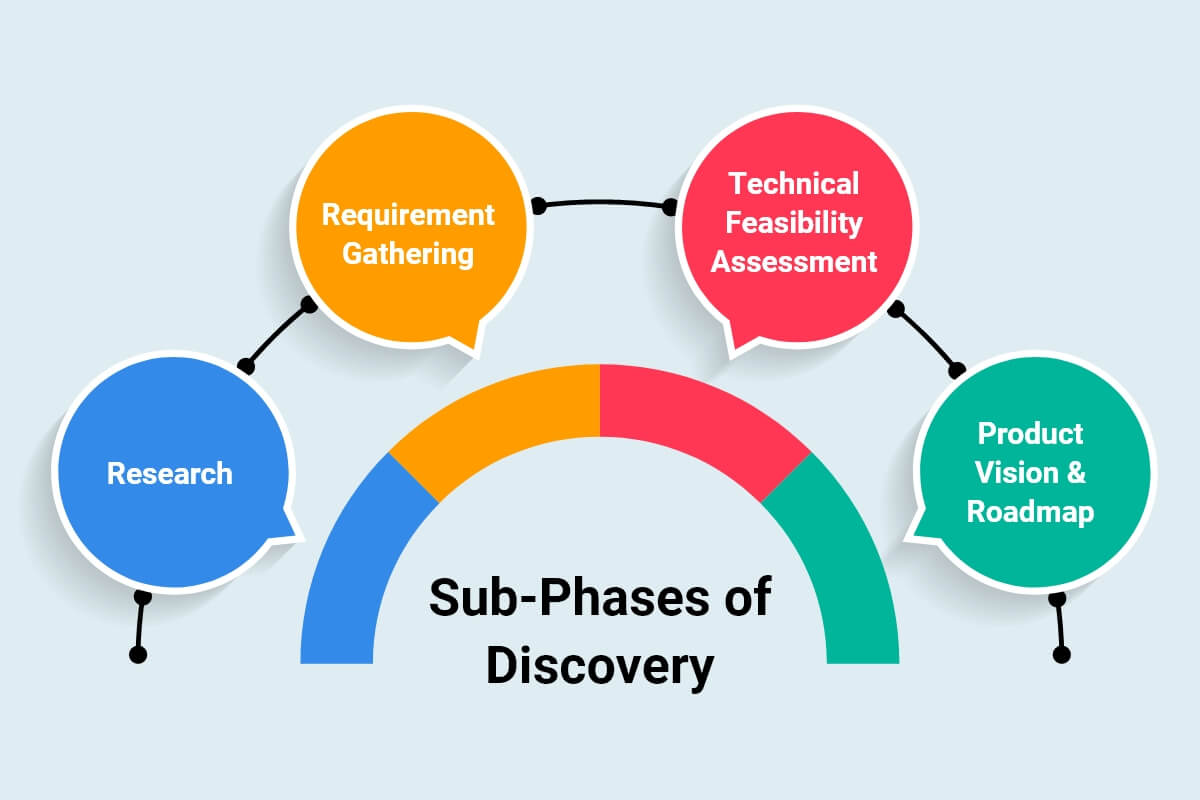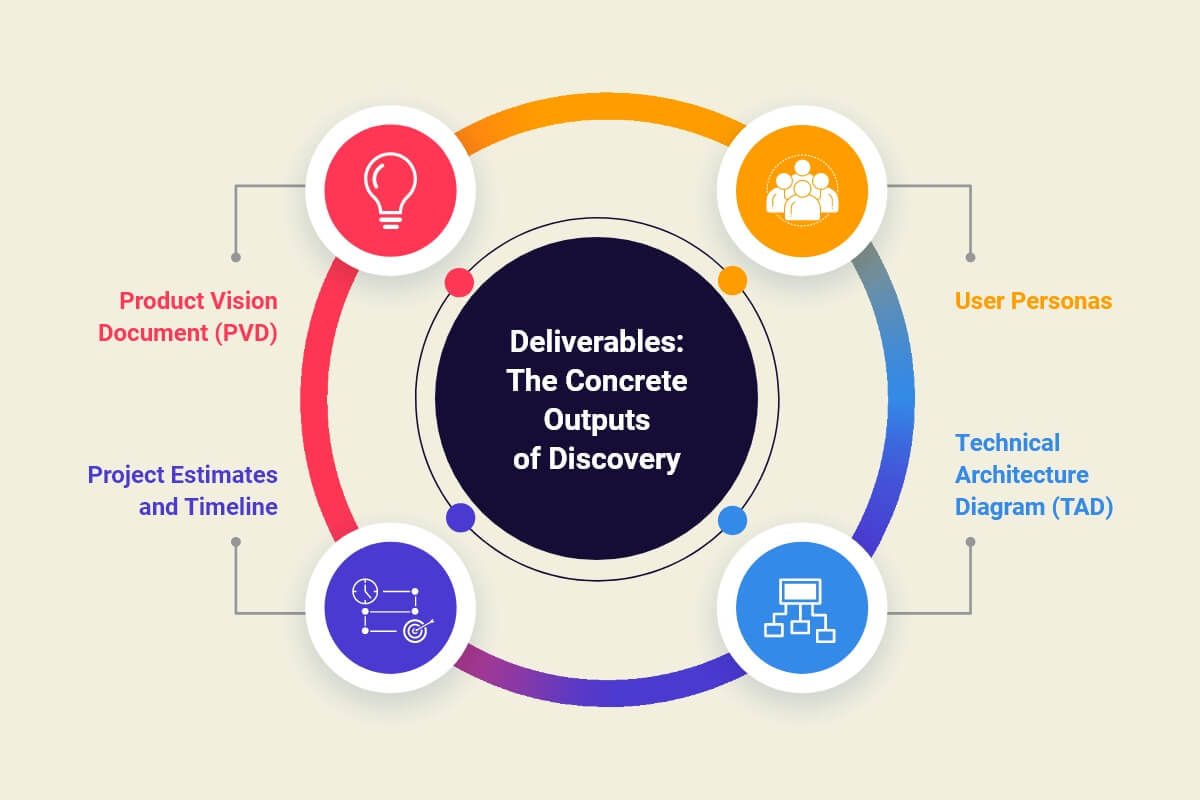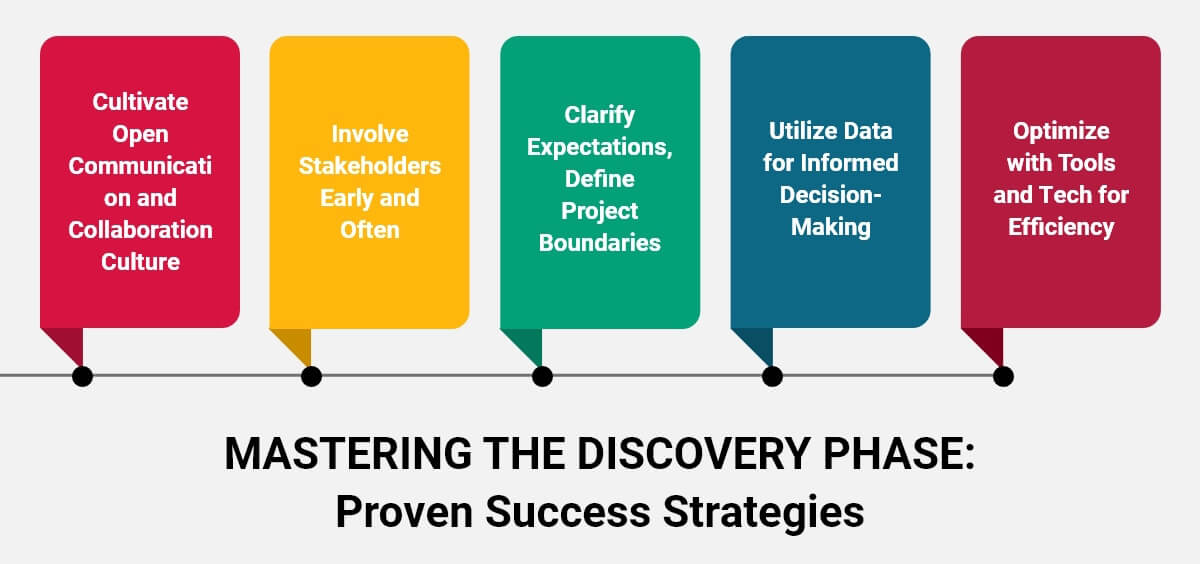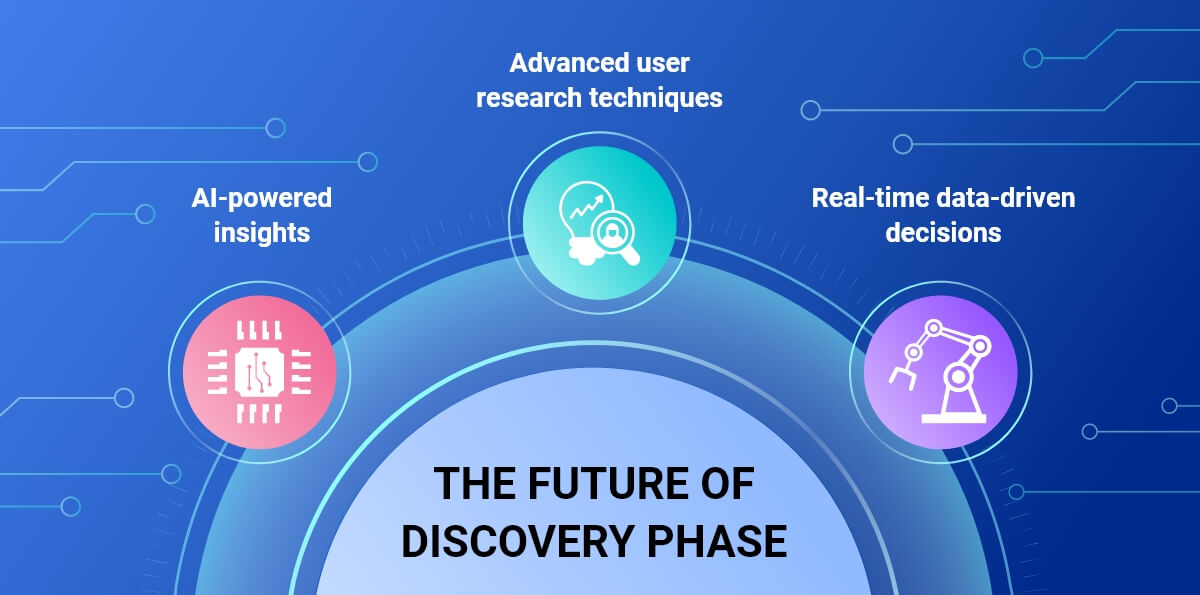In the fast-paced world of software development, where delivery deadlines loom and competition is fierce, one crucial stage in SDLC often gets overlooked: The Discovery Phase. This critical pre‑development step holds the key to unlocking successful custom software development—especially in Greenfield Software Development, where building from scratch demands a clear vision and strong foundations-to avoid costly pitfalls.
Want to eliminate costly surprises and keep your software project on track?
Demystifying the Discovery Phase
Think of the Discovery Phase as a meticulous exploration before undertaking a complex software project. It’s the stage where you gather vital information (research), understand the needs of your target audience (user research), analyze competitor offerings (competitive analysis), and assess feasibility (technical assessment). By thoroughly exploring these aspects, you lay a solid foundation for a successful software project development, much like a well-designed blueprint that guides construction.
Benefits of a Dedicated Discovery Phase
A dedicated Discovery Phase isn’t just about planning; it’s a powerful tool for risk mitigation. By identifying potential issues like scope creep, misaligned features, and unrealistic timelines early on, you can avoid costly rework and ensure your software project’s stability. Studies show that a thorough Discovery Phase can reduce software development costs by up to 30% and significantly improve success rates. It’s an investment that pays off in spades.
Delving into the Sub-Phases of Discovery
The Discovery Phase isn’t a monolithic entity; it’s a symphony of interconnected sub-phases, each contributing to the overall success of the custom software development. Here are some key sub-phases to explore:
Research
This sub-phase covers about gathering vital information about the market, competitors, and industry trends through market research reports, user interviews, and competitor analysis.
Market Research Reports: Analyze industry reports, white papers, case studies, and trend forecasts to understand the target market size, growth potential, and various key factors influencing it. Identify user demographics, buying behaviors, and their pain points.
User Interviews: Conduct qualitative interviews with potential users to gain first-hand insights into their needs, frustrations, and anticipations for the software. Ask open-ended questions to discover hidden desires and understand their day-to-day workflows.
Competitive Analysis: Research your competitors’ offerings, analyzing their features, USPs, strengths, weaknesses, and pricing models. Identify the opportunities to differentiate your software product and address unmet user needs.
Trend Analysis: Keep your finger on the pulse of emerging technologies and industry shifts that could impact your software product’s success. Explore potential opportunities and adjust your vision accordingly.

Requirement Gathering
Understand what your software product’s users need and want through user workshops, focus groups, and user persona development.
User Workshops: Facilitate interactive workshops where users collaborate to identify specific problems, brainstorm various solutions, and prioritize software features based on their value and feasibility.
Focus Groups: Gather targeted groups of users with specific demographics or needs to discuss their unique viewpoints and challenges. Observe their interactions and collect valuable insights.
Surveys & Questionnaires: Use quantitative methods like surveys and questionnaires to gather more comprehensive data on user preferences, behaviors, and priorities. Analyze the data to identify trends and commonalities.
User Persona Development: Create detailed profiles of your ideal users, encompassing their demographics, motivations, goals, and pain points. These personas help empathize with users and design software solutions that resonate with them.
Technical Feasibility Assessment
Analyze technical constraints, available resources, and potential software development challenges to ensure a realistic and achievable software product.
Technical Constraints: Analyze existing software systems, infrastructure limitations, and compatibility requirements to ensure the chosen technology stack can support the envisioned features, upgrades and functionality.
Available Resources: Assess the team’s expertise, skillsets, and access to necessary tools and technologies to determine the feasibility of custom software development within project constraints.
Potential Software Development Challenges: Identify potential technical hurdles like complex integrations, performance bottlenecks, future maintenance, or security vulnerabilities. Plan appropriate mitigation strategies and contingency plans to address all such challenges.
Prototype Development: Consider building low-fidelity prototypes to evaluate technical feasibility, identify potential integration issues, and provide users with a tangible representation of the software product.
Product Vision & Roadmap
Define your software product’s core value proposition, target audience, differentiators from your competitor and key features. This vision then translates into a roadmap that outlines the software development journey, ensuring everyone is aligned with the expected end results.
Core Value Proposition: Define the fundamental problem your software product solves and the unique value it offers to users compared to competitors. Articulate how it will make their lives easier or better.
Target Audience: Identify the specific user groups your software product caters to, encompassing their demographics, needs, behaviors, etc. Narrowing your focus ensures targeted development and resonates with the users expectations accurately.
Key Features: Prioritize the essential features that deliver the core value proposition and address user needs. Consider short-term and long-term goals, balancing immediate impact with future functionality.
Development Roadmap: Create a phased plan outlining the software development timeline, feature release schedule, and resource allocation for each stage. Ensure everyone is aligned on the journey and milestones.
Also, read our blog on Prompt Engineering in Software Development
Deliverables: The Concrete Outputs of Discovery
The Discovery Phase isn’t just about abstract insights or about brainstorming and discussions; it yields tangible deliverables that guide the software project development trajectory. Let’s explore each deliverable in detail.
Product Vision Document (PVD)
A PVD is a detailed document outlining the product’s purpose, target audience, and key features, serving as a north star for software product development. Think of the PVD as your project’s constitution, it clearly defines the “why” behind your software product.
Purpose: What problem does your product solve? What value does it offer to users?
Target Audience: Who are you building this product for? Understanding their needs, pain points and behaviors is crucial.
Key Features: What are the essential functionalities that deliver the core value proposition? Prioritize based on user needs and impact.
Competitive Landscape: How does your product stand out? Differentiate yourself and address unmet user needs.
Success Metrics: How will you measure the product’s success? Define metrics aligned with your vision and target audience.

User Personas
In-depth profiles of your ideal users helps to empathize with their software needs and design software solutions that resonate with them. These aren’t fictional characters; they’re detailed profiles of your ideal users, based on real data and insights. Consider:
Demographics: Age, location, profession, lifestyle choices.
Needs & Goals: What problems do they face? What are their aspirations?
Motivations & Pain Points: What drives them? What frustrates them?
Tech Savvy & Preferences: How comfortable are they with technology? What interfaces do they prefer?
Quotes & Anecdotes: Include real quotes from user research to give life to your personas.
By empathizing with these personas, your software development team can design solutions that truly resonate with your target audience.
Technical Architecture Diagram (TAD)
A blueprint of the system’s technical infrastructure, ensuring scalability and maintainability. It covers,
System Components: Servers, databases, APIs, frameworks, etc.
Data Flow: How information moves through the system.
Integration Points: How different components connect and interact.
Security Considerations: Measures to protect user data and system integrity.
The TAD ensures your chosen technology stack can support the envisioned features and lays the foundation for a maintainable and scalable software system.
Project Estimates and Timeline
A realistic assessment of the resources and time required to bring the vision to life. This includes:
Task Breakdown: Detailed list of development tasks and their complexity.
Resource Allocation: Assigning specific tasks to team members based on skills and availability.
Time Estimates: Realistic timeframe for each task and the overall software project delivery.
Budget Considerations: Factor in personnel costs, technology tools, and potential contingencies.
This tangible roadmap keeps everyone aligned, facilitates efficient resource allocation, and prevents costly surprises down the line.
Remember, these deliverables are living documents, evolving as the software project progresses and new insights emerge. The key is to use them effectively to maintain a clear direction, ensure informed decision-making, and ultimately, deliver a successful custom software product that meets its target audience’s needs.
Ready to uncover potential challenges and ensure your project is set up for success from the start?
Challenges and Pitfalls to Navigate
Even the most seasoned project managers encounter hurdles. Common challenges in the Discovery Phase include:
- Stakeholder alignment: Keeping everyone on the same page requires effective communication and collaboration.
- Scope creep: The ever-present temptation to add new features can derail the software development project. Clearly defined boundaries and priorities are crucial to keep software development on track.
- Limited resources: With tight budgets and timelines, it’s important to prioritize tasks and focus on the most critical activities.
Conquering the Discovery Phase: Proven Strategies for Success

The Discovery Phase might seem daunting, but fear not! Here are some actionable tips to overcome common challenges and navigate this crucial stage with confidence:
Foster a Culture of Open Communication and Collaboration
Break down silos: Encourage information sharing between departments, from software developers and UI UX designers to marketers and executives. Regular cross-functional workshops and brainstorming sessions can spark innovative ideas and unearth hidden insights.
Embrace transparency: Keep stakeholders informed at every step, sharing findings, challenges, and potential roadblocks openly. This promotes trust, fosters buy-in, and allows for course correction when needed.
Actively listen to diverse perspectives: Value and integrate feedback from everyone involved, not just senior leadership. User researchers, developers, and even sales representatives can offer valuable insights from their unique viewpoints.
Involve Stakeholders Early and Often
Identify key stakeholders: Map out who needs to be involved in the Discovery Phase, from decision-makers and end-users to technical experts and legal representatives. Ensure everyone understands their roles and responsibilities.
Hold regular stakeholder meetings: Schedule regular meetings to keep everyone informed, discuss progress, and address concerns. Actively encourage participation and solicit feedback to maintain alignment throughout the process.
Manage expectations proactively: Be transparent about delivery timelines, potential challenges, and resource requirements. Set realistic expectations to avoid disappointment at a later stage and ensure stakeholders are prepared for the journey ahead.
Set Clear Expectations and Define Project Boundaries
Articulate a clear vision and goals: Define the project’s purpose, target audience, and desired outcomes. This provides a guiding star for the Discovery Phase and ensures everyone is working towards the same objective.
Scope the software project strategically: Prioritize features and functionalities based on user needs, business impact, and technical feasibility. Define clear boundaries to avoid scope creep and ensure the project remains focused and achievable.
Establish decision-making protocols: Determine who has the authority to make key decisions at different stages of the Discovery Phase. Clear protocols reduce ambiguity and ensure timely progress.
Use Data-Driven Insights and Evidence to Guide Decision-Making
Leverage user research: Conduct surveys, interviews, and usability testing to understand user needs, behaviors, and expectations. Data-driven insights inform feature prioritization, design decisions, and ensure the final software product resonates with its target audience.
Analyze market trends and competitor research: Stay informed about industry trends, emerging software development technologies, and competitor offerings. This data helps identify opportunities, mitigate risks, and position your software effectively.
Utilize data visualization tools: Present research findings, market data, and technical assessments in clear and accessible formats. This facilitates discussions, improves understanding, and supports informed decision-making.
Leverage Tools and Technologies to Streamline the Process
Project management software: Tools like Asana, Jira, Zoho Projects or Trello help organize tasks, track progress, and manage resources effectively. They improve communication, collaboration, and transparency throughout the Discovery Phase.
User research platforms: Tools like Maze or UserTesting streamline user research by enabling online surveys, prototyping, and usability testing. They expedite data collection and provide valuable insights into user behavior.
Data analysis tools: Software like Tableau, Looker Studio or Power BI help visualize and analyze market data, user research findings, and technical assessments. This provides actionable insights to guide decision-making and prioritize features.
By implementing these strategies, you can navigate the Discovery Phase with confidence, overcome challenges, and set your software project on the path to success. Remember, a thorough and well-executed Discovery Phase lays the foundation for a user-centric, efficient, and ultimately successful software product engineering.
Measuring the Discovery Phase’s Impact
Just like you gauge a project’s success by its deliverables, you can measure the Discovery Phase’s impact through specific metrics:
- Reduced project risk: Track the decrease in potential issues identified and addressed during the Discovery Phase.
- Improved user satisfaction: Monitor user feedback and engagement after launch to gauge the alignment with their needs.
- Increased project ROI: Compare the projected benefits against the actual outcomes to see if the Discovery Phase paid off.
The Future of Discovery Phase: A Continuously Evolving Process
The Discovery Phase is not static; it evolves alongside the software development landscape. Emerging trends like AI-powered insights, advanced user research techniques, and even virtual prototypes are set to further refine and enhance this critical stage. These advancements will make the Discovery Phase even more user-centric and lead to even more successful software project deliveries. The future of the Discovery Phase is bright, powered by innovation and a constant focus on user needs. Here’s a glimpse into what’s to come:

- AI-powered insights: Imagine intelligent tools analyzing vast amounts of user data and recommending features that perfectly align with their needs. This data-driven approach will revolutionize requirement gathering and ensure the development of truly user-centric software products.
- Advanced user research techniques: Virtual reality and augmented reality can create immersive prototypes, allowing users to interact with software before it’s even built. This firsthand experience will further refine the Discovery Phase and lead to a higher level of user satisfaction.
- Real-time data-driven decisions: As the lines between software development and deployment blur, the Discovery Phase will become more iterative and agile. Real-time data on user behavior and market trends will inform ongoing development, ensuring the software remains relevant and adaptable to changing needs.
Embrace the Discovery Phase
The software development landscape is fraught with risks, including challenges in ongoing software maintenance. Unrealistic expectations, misaligned features, and technical hurdles can quickly transform promising projects into costly failures. In this perilous terrain, the Discovery Phase emerges as a beacon of clarity, a strategic cornerstone upon which successful software solutions are built.
Far from a cursory pre-development step, the Discovery Phase is a proactive investment in project resilience and user satisfaction. It’s a meticulous exploration, a thorough excavation of user needs, technical feasibility, and market insights. By dedicating time and resources to this vital stage, you unlock a treasure trove of benefits.
When combined with a software cost estimation tool, the Discovery Phase ensures that your project begins with a clear roadmap and a realistic budget. This powerful combination helps you anticipate challenges, allocate resources wisely, and set your project up for success.
The Discovery Phase is no longer a luxury; it’s a necessity. By embracing this crucial stage, you’re not just investing in your project’s success; you’re investing in your users’ satisfaction and your company’s future. So, champion the Discovery Phase within your organization, equip your teams with the right tools and knowledge, and watch your software projects soar to new heights.
Ready to gain clarity and control over project costs before development begins?
Testimonials: Hear It Straight From Our Customers
Our development processes delivers dynamic solutions to tackle business challenges, optimize costs, and drive digital transformation. Expert-backed solutions enhance client retention and online presence, with proven success stories highlighting real-world problem-solving through innovative applications. Our esteemed clients just experienced it.